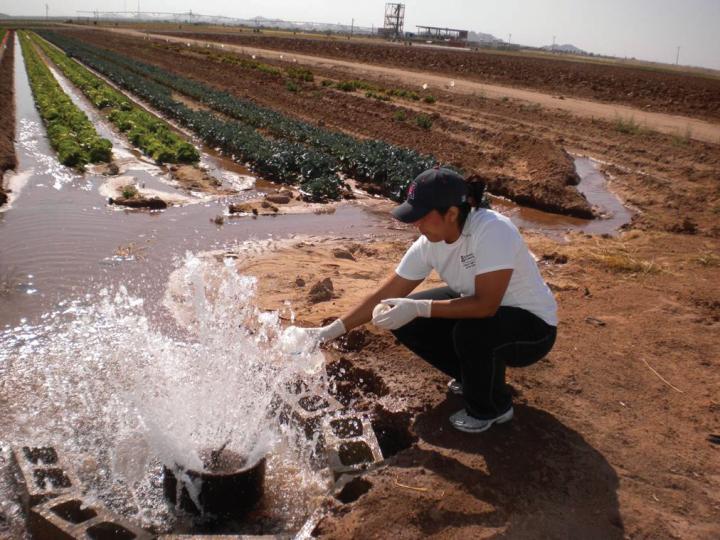
Credit: Natalie Brassill, University of Arizona.
March 20, 2019 – Salads were recently in the news–and off America’s dinner tables–when romaine lettuce was recalled nationwide. Outbreaks of intestinal illness were traced to romaine lettuce contaminated with Escherichia coli (E. coli) bacteria.
These bacteria occur naturally in the intestines of warm-blooded animals. Because crops are grown in the natural environment, E.coli may get into the fields, contaminating produce. The results are potentially deadly for people who eat that produce.
Cooking kills E. coli, removing the danger. But lettuce and other leafy greens are generally eaten raw, so they present special safety issues. To protect the public, strict rules require producers to test their irrigation water to see if it is contaminated with E. coli or other microorganisms that can cause illness. The produce industry implements these food safety measures to keep people safe and grow a reliable, nutritious product for consumers.
Are the irrigation water tests consistent enough to prevent future widespread recalls? Researchers are comparing tests to see.
In 2011, the U.S. Food and Drug Administration proposed ten EPA-approved tests to detect generic E.coli in irrigation water. One of these methods, mTEC®, is an excellent test for generic E. coli but has not been commonly used in the water testing industry. A commercially available test kit, Colilert®, is much simpler to use. It is also offered by hundreds of water quality testing laboratories nationwide, compared to only a handful of laboratories that offer the mTEC® assay.
Research scientist Jean E. McLain and colleagues at the University of Arizona felt it was important to discover how good laboratories are at using these tests, and whether test results are consistent from lab to lab. Each month, a technician collected a water sample from irrigation canals at the university’s research farms near Yuma and Maricopa, AZ. Each water sample was divided into thirds: one-third was delivered to McLain’s lab and the remainder was delivered to two collaborating labs for testing.
“This study used a side-by-side comparison of both methods, across three laboratories, to test how well the method results were reproduced across labs,” says McLain. “Both methods have shown excellent results as long as water samples are clean. But because these methods were developed for drinking water, they may not work as well with environmental water samples, which can contain salts, sediments, and naturally-occurring microbes.”
Field samples of irrigation water can include salts and sediments when rivers are muddied from rain. Because the Arizona water samples were usually very clean, the researchers sometimes added sediment, salts or bacteria like E. coli to the samples before sending them off for testing.
Each lab put its samples through the two certified methods to identify the amount of generic E. coli in the sample. Both tests performed very well when there were no additions to the water as well as when salts and sediments were added.
“But when microbes were added, the consistency fell apart,” McLain reported. “For both the mTEC® and Colilert® tests, two labs found the levels of generic E. coli were very high–way above the safety standard. But for each test, one of the three labs showed that the water quality was within the safety threshold.”
“The Colilert® test is so straightforward that labs generally get same results,” McLain said. “But in this study comparing the two methods, we are not seeing the same results with each test and each lab. Why would labs have such disparate results? That will be the focus of the rest of the study.”
One suggestion is that some of these methods are very subjective, requiring highly-trained technicians to evaluate the test results. All water testing completed by the leafy greens industry must be conducted at a certified laboratory, and any presumptive positive results for pathogens must be tested a second time to confirm their presence.
In the next phase of research, McLain and her collaborators will gather more data about the varying conditions that may affect test results, including environmental factors and technician training. The team’s goal is to develop a user-friendly guide for industry that will help ensure consistently accurate test results.
###
McLain presented her research at the Annual Meeting of the Soil Science Society of America, Jan. 6-9, in San Diego, CA. This work is funded by the Arizona Department of Agriculture, Specialty Crop Block Grant Program.
Media Contact
Susan V. Fisk
[email protected]




